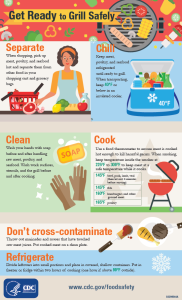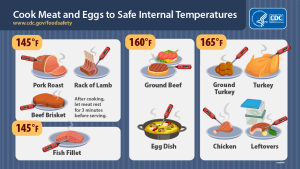Food Safety
As the weather starts to get warmer, a lot of us tend to spend more time grilling and eating meals outdoors at various events. Spending time relaxing with family and friends is one of the best parts of the summer, plus, there are some foods that just seem to taste better during this time of the year. Practicing food safety measures is probably the most important thing when it comes to making sure that those foods taste as great as they can, while ensuring everyone has a good time in the process. Nothing can ruin a good BBQ quite like foodborne illness! The good news is that taking some small precautions while preparing the food can keep everyone safe, healthy, and happy.
While these tips are for everyone regardless of their health status, there are some individuals who are at a higher risk of developing a foodborne illness, as their immune system is not as strong. Some of those who are at a higher risk may include those that are older than 65, children under 5, those undergoing cancer treatment, those with liver or kidney disease, individuals that take immunosuppressive medications, and women who are pregnant.

Wash your hands– One of the most important things you can do to limit risk of foodborne illness is wash your hands and wash them often! This can help prevent bacteria from spreading to other items and causing illness. Make sure to wash your hands before, during, and after preparing any food item. This is especially true after handling any raw meat, poultry, seafood, or raw egg products. Wash your hands after you sneeze, cough, blow your nose, have or treat a cut or wound, and after touching any garbage.
Keep surfaces clean– Always use a clean cutting board and knife. Make sure to use separate cutting boards and utensils for produce and for raw meats. Clean all items with hot, soapy water or in the dishwasher if they are dishwasher safe after each use. If cutting boards are worn or have hard to clean grooves, it is best to replace them, as these areas are hard to clean and bacteria can continue to grow and spread. Also, always use separate plates for raw meats and cooked meats.
Cook meat, chicken, eggs, and seafood thoroughly– Keeping a food thermometer on hand is one of best tools for promoting food safety. You can find a good food thermometer at a very reasonable price and different kinds are available at most stores or online. The color and texture of meats are not always reliable indicators that the food is cooked and safe. Thermometers can take all the guesswork out of figuring out if a piece of chicken is done or not. This small investment can save a lot of time and headache over the long run. Safe Internal Temperatures Are:
- Pork, Lamb, Fish: 145 degrees
- Ground Beef: 160 degrees
- Poultry: 165 degrees
- Leftovers: 165 degrees

Thaw meats correctly- While it may be tempting at times to thaw meat by leaving it out on the counter, this method can be potentially dangerous. Freezing foods does not kill any bacteria or pathogens, it just prevents the multiplication and spreading. If the food starts to warm up to 41 degrees or higher, those bacteria will start growing again, which can make the food unsafe to eat. The safest ways to thaw frozen meats is in the refrigerator, in water, or in the microwave. If thawing in water, make sure the food is in a leak-proof package to prevent any bacteria from spreading to other surfaces. If you choose to thaw using the microwave, make sure you will be able to cook the food immediately after.
Store foods at a safe temperature- Bacteria tend to grow rapidly at certain temperatures, more specifically between 40-140 degrees. This range is known as the “Danger Zone”. The amount of bacteria can almost double in as little as 20 minutes if left in this zone.
- Keep hot foods hot- when serving hot foods, make sure they are kept at or above 140 degrees.
- Keep cold foods cold- cold foods should be kept at or below 40 degrees.
It is extremely important to monitor these temperatures if food is going to be sitting out very long before being served or eaten, as bacteria can spread quickly.
While food safety recommendations may not be the most exciting thing, they really can make a huge difference. This will ensure everyone can enjoy a meal while staying happy and healthy!

